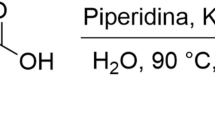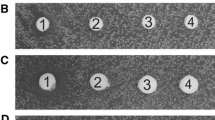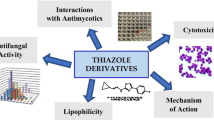Abstract
The antifungal properties of 25-azalanosterol was investigated. Compared to normal antifungal reagents, fluoconazole, clotrimazole and voriconazole, it exhibited significant anti-Candida activity (the minimum inhibitory concentration [MIC] ranges were 0.125–8, 0.5–8 and 0.5–32 µg/mL against C. albicans, C. krusei and C. glabrata, respectively), but showed little toxicity to mice liver cells at clinical dosage after 24 h of exposure, with the lowest lactate dehydrogenase and the highest ED50 compared to four other azoles antifungal agents. 25-Azalanosterol inhibited the incorporation of [methyl-3H3] AdoMet into the C-24 of ergosterol in whole cells of C. albicans. Thus, 25-azalanosterol, as an inhibitor of the growth of C. albicans in vitro, may have considerable potential as a new class of anti-Candida agent that lacks toxic side effects in the mammalian host.





Similar content being viewed by others
References
Long SS, Stevenson DK (2005) Reducing Candida infections during neonatal intensive care: management choices, infection control, and fluconazole prophylaxis. J Pediatr 147:135–141
Blyth CC, Palasanthiran P, O’Brien TA (2007) Antifungal therapy in children with invasive fungal infections: a systematic review. Pediatrics 119:772–784
Pfaller MA, Pappas PG, Wingard JR (2006) Invasive fungal pathogens: current epidemiological trends. Clin Infect Dis 43:S3–S14
Fidel PL Jr, Vazquez JA, Sobel JD (1999) Candida glabrata: review of epidemiology, pathogenesis, and clinical disease with comparison to C. albicans. Clin Microbiol Rev 12:80–96
Hoppe JE (1997) Treatment of oropharyngeal candidiasis and candidal diaper dermatitis in neonates and infants: review and reappraisal. Pediatr Infect Dis J 16:885–894
Kauffman CA (2006) Endemic mycoses: blastomycosis, histoplasmosis, and sporotrichosis. Clin Infect Dis N Am 20:645–662
Kaufman D, Boyle R, Hazen KC, Patrie JT, Robinson M, Grossman LB (2005) Twice weekly fluconazole prophylaxis for prevention of invasive Candida infection in high-risk infants of <1000 grams birth weight. J Pediatr 147:172–179
Kim CK, Jeon KI, Lim DM, Johng T, Trzaskos JM, Gaylor JL, Paik YK (1995) Cholesterol biosynthesis from lanosterol: regulation and purification of rat hepatic sterol 14-reductase. Biochim Biophys Acta 1259:39–48
Kanagasabai R, Zhou WX, Liu JL, Nguyen TT, Veeramachaneni P, Nes WD (2004) Disruption of ergosterol biosynthesis, growth, and the morphological transition in Candida albicans by sterol methyltransferase inhibitors containing sulfur at C-25 in the sterol side chain. Lipids 39:737–746
Zhou WX, Lepesheva GI, Waterman MR, Nes WD (2006) Mechanistic analysis of a multiple product sterol methyltransferase implicated in ergosterol biosynthesis in Trypanosoma brucei. J Biol Chem 281:6290–6296
Kaneshiro ES, Rosenfeld JA, Basselin M, Stringer JR, Keely S, Smulian AG, Giner JL (2002) The Pneumocystis carinii drug target S-adenosyl-L-methionine: sterol C-24 methyl transferase has a unique substrate preference. Mol Microbiol 44:989–999
Zhou WX, Cross GA, Nes WD (2007) Cholesterol import fails to prevent catalyst-based inhibition of ergosterol synthesis and cell proliferation of Trypanosoma brucei. J Lipid Res 48:665–673
Wang JQ, Liu JL, Song ZH, Nes WD (2008) Sterol C24-methyltransferase: mechanistic studies of the C-methylation reaction with 24-fluorocycloartenol. Bioorg Med Chem Lett 18:232–235
Nes WD, Jayasimha P, Zhou WX, Kanagasabai R, Jin C, Jaradat TT, Shaw RW, Bujnicki JM (2004) Sterol methyltransferase: functional analysis of highly conserved residues by site-directed mutagenesis. Biochemistry 43:569–576
Arora A, Raghuraman H, Chattopadhyay A (2004) Influence of cholesterol and ergosterol on membrane dynamics: a fluorescence approach. Biochem Biophys Res Commun 318:920–926
Deyes R (2002) Cell viability assays. Promega Notes 81:32–33
Nanotechnology Characterization Laboratory (NCL) (2006) HEP G2 hepatocarcinoma cytotoxicity assay. NCL Method GTA-2. SAIC-Frederick Inc. pp 3–7
Wang JQ, Nes WD (2008) Mechanism and scope of cyclobranol modulated 24-sterol methyltransferase catalysis enzyme inactivation and concurrent C24-alkylation and dealkylation. J Biol Chem (in Press)
Worsham DN, Basselin M, Smulian AG, Beach DH, Kaneshiro ES (2003) Evidence for cholesterol scavenging by Pneumocystis and potential modifications of host-synthesized sterols by the P. carinii SAM:SMT. J Eukaryot Microbiol 50:678–679
Smith PB, Steinbach WJ, Benjamin DK Jr (2005) Neonatal candidiasis. Infect Dis Clin North Am 19:603–615
Zaoutis TE, Heydon K, Localio R, Walsh TJ, Feudtner C (2007) Outcomes attributable to neonatal candidiasis. Clin Infect Dis 44:1187–1193
Song ZH, Zhou WX, Liu JL, Nes WD (2004) Mechanism-based active site modification of the soybean sterol methyltransferase by 26,27-dehydrocycloartenol. Bioorg Med Chem Lett 14:33–36
Taylor FR, Rodriguez RJ, Parks LW (1983) Relationship between antifungal activity and inhibition of sterol biosynthesis in miconazole, clotrimazole, and 15-azasterol. Antimicrob Agents Chemother 23:515–521
Borgers M, Van den Bossche H (1982) The mode of action of antifungal drugs. Ketoconazole in the management of fungal disease. Adis Press, New York, pp 25–47
Acknowledgement
The authors wish to thank Prof. W. D. Nes for his assistance in the experimental procedures and the manuscript preparation.
Author information
Authors and Affiliations
Corresponding author
Rights and permissions
About this article
Cite this article
Wang, J., Wu, J. Antifungal activity of 25-azalanosterol against Candida species. Eur J Clin Microbiol Infect Dis 27, 1131–1136 (2008). https://doi.org/10.1007/s10096-008-0554-y
Received:
Accepted:
Published:
Issue Date:
DOI: https://doi.org/10.1007/s10096-008-0554-y




